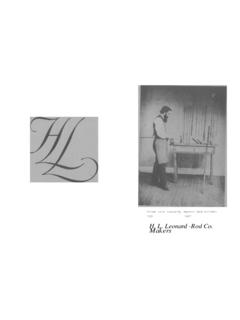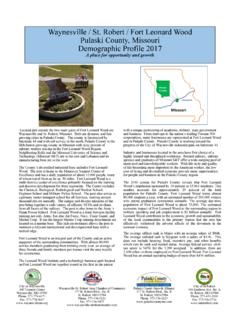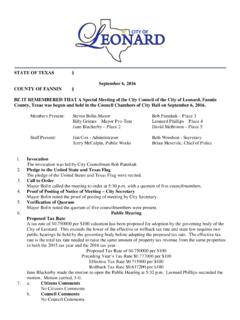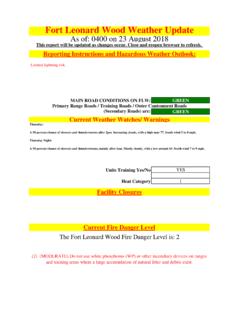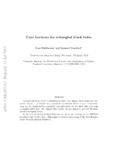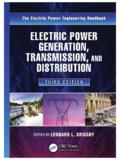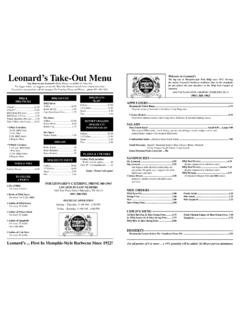Transcription of DFSIGN, CONSTRUCTION & OPERATING - Rex Research
1 dfsign , CONSTRUCTION & OPERATING PRINCIPLES OF ELECTROMAGNETS FOR AITRACTING COPPER, ALUMINUM & OTHER NON-FERROUS METALS by leonard R. Crow EDUCATIONAL SPECIALIST In Devtlopment of Electrical instruclion DIRECTOR OF Research AND DEVELOPMENT OF Universal Scientific Company, Inc. THE SCIENTIFIC BOOK PUBLISHING CO. VINCENNES, INDIANA 1 9 5 1 Disclaimer Operation of the magnet described herein requires the use of 115 volts AC (Alternating Current) The voltages and currents used are lethal. The reprinter of this book, Benjamin Fleming, as well as the various distributors of this publication, including but not limited to Lindsay Publications Inc . have not built this project nor do they endorse the methods herein described. The said Fleming as well as the distributors assume no liability for injury to persons or property that may result while building, testing ,or operations in any way, of the described magnet. The intent of this publication is for educational purposes only.
2 PREFACE Back in 1935 I gave a public lecture demonstration at the physics department of Dlinois University In which I used an electrical training aid of my own de sign and CONSTRUCTION to show that an electromagnet could be used to attract non ferromagnetic metals of good electrical conductivity. In the following five years I devoted much thought, time, and effort to making various types, styles and sizes of electromagnets with which I could produce attraction of non ferrous-metals effectively. Following Is a descrIption of, and basic fundamental OPERATING principles pertainIng to the type of elec tromagnet that I have found most effective for the attraction of non ferrous-metals. note I am very interested in communicating with individuals and or companies that have in the past, or are currently using this magnet technology. Should you know of additional articleslbooks etc. or individuals that have knowledge relating to this subject matter please contact me at: Benjamin Fleming 1734 Viewpoint Dr.
3 Fayetteville Arkansas 72701 or e-mail NOTICE Some of the devices and constructions lllustrated and described in this book are covered by letters patent. Designers and manufacturers are warned to check the patent situation thoroughly, before in corporating any of the embodiments described herewith into their own designs or constructions. Illustration or description in this book must not be construed to Imply that a device, system or con struction shown herein Is common property avail able for public use by anyone. Accordingly, there fore, the publishers or author will not assume any responsibility for damages arising out of litigation involving Infringement suits relative to any system, CONSTRUCTION or apparatus described herein. ELECTROMAGNETS OF SPEClAL CONSTRUCTION FOR THE ATTRACTION OF NON-FERROMAGNETIC METALS Magnetism is one of the most interesting and mysterious as well as one of the most important physical phenomena known. Through its action we generate and utilize the enormous quan tities of electrical power which make possible modern industry and modern living.
4 Many important principles of electromag netism can be understood from the study of an electromagnet, invented and designed by the author, which attracts non-ferro magnetic metals. Everyone has experimented with magnets and observed their attraction for iron filings, nailS, and other small articles of iron and steel. Some of you will have seen large electromag nets attached to cranes pick up tons of scrap steel and move it about with ease. Tons of iron are held firmly to the magnet with an invisible force and are released by the flip of a switch. You have also observed that while iron is attracted with such force, other metals such as aluminum, copper, and silver are unaffected. This principle is often used to separate iron from non-ferrous metals. No doubt you have used a magnet to deter mine whether a nickel plated screw had an iron or brass base. You may also have noticed that if alternating current is applIed Figure 1 2 ELECTROMAGNETS Figure 2 to an ordinary electromagnet, non-magnetic metals of good electrical conductivity wlll actually be repelled.
5 In view of all of the above it will be most interesting to learn how magnetism can be used to attract non-ferromagnetic metals. In 1934 the author designed equipment with which It was pos sible to demonstrate principles whereby non-ferromagnetic metals might be attracted by a special magnet. In 1940 the author completed the development and CONSTRUCTION of an elec tromagnet which would actually attract metals such as alumi num, copper and silver. In fact the magnet would attract any metal of fair or good electrical conductivity. Toward the end of 1947 the author completed the deslgn and CONSTRUCTION of a much improved electromagnet for the attraction cif non-ferrous metals, the details and descrIption of which are Included In this article. The special electromagnet is iUuslrated in FIgure 1. In FIgure 2 the magnet, with its axIs horizontal, is shown supporting a heavy piece of copper. In FIgure 3 two pieces of aluminum have been added to the original piece of copper.
6 Figure 4 shows the magnet supporting two sUver dollars. The size of the magnet is Ulustrated by comparison with the silver dollars. That the magnet may also be used to attract iron is indicated clearly in Figure 5. Before considering the details of CONSTRUCTION and principles of operation of the special electromagnet, let us review some of the basic principles of magnetism and electromagnetism. DESIGN, CONSTRUCTION , AND OPERATING PRINCIPLES 3 Figure 3 We wlll not only observe that non-ferromagnetic metals can be attracted to an electromagnet but wUI also gain the pleasure of understanding its principles of action. Oersted in 1819 was the first to show that a current carrying wire was by a magnetic !leld. He discovered that a compass needle aligns ltseU at right angles to a wire carrying Figure" 4 ELECTROMAGNETS Figure 5 an electric current. Thus it is known that in a circuit similar to that in Figure 6, there will be a magnetic fIeld about the wire In the direction shown.
7 The current direction is in accordance DR' CEll Figure 6 DESIGN, CONSTRUCTION , AND OPERATING PRINCIPLES 5 with the conventional explanation that current flow is from posi tive to negative. If a compass is placed above the wire it wUl point in the di rection shown In Figure 7-A, pointing at right angles to the cur rent carrying conductor. The compass needle will point in the direction that the flux lines are moving. H the current is re versed as In Figure 7-B the compass wlll point in the opposite direction as shown and we know the flux lines have reversed their direction. O-CD ) ()-m ) Figure 7 If we place a number of magnetic needles or compasses about a current carrying conductor In the manner shown in Figure 8 the compass needles wUl poInt In the direcUons illustrated. I 1 " 1 1 A B Figure B 6 ELECTROMAGNETS This indicates very clearly that the magneUc lines of force are directed in a circular path around the conductor and that their direction reverses with a reversal of current in the conductor.
8 To determine the direction of the !lux lines we grasp the conductor in the right hand with the thumb JKlinUng in the direc tion of the current. Then the fingers encircle the wire in the direction of the flux Hnes (see Figure 9). This is known as the Right Hand Rule. CONOUCTOR -1 ..-THUMI POINTED IN DIRECTION OFCURII. NT DIREcn;;;" ;:t, :> J.:-OF MAGNETIC FlUX I Figure 9 Now let two parallel wires carrying current in the same di rection be placed near each other as in Figure 10. The compass will point in the direction shown in Figure lO-A l! placed above either wire and will also point in the same direction U shifted to any posltion above the two wires. However, it w1l1 reverse Its direction when placed underneath either or both oC the wires (Figure 10-B). Thus we conclude that flux lines encircle each wire and also that there are lines extending around or encircling both wires. We can now deduce two important properties of flux lines. It is to be observed by experiment that parallel wires such as those illustrated In Figure 11 are attracted by the magnetic ac tion of the two currents flowing In the same directlon.
9 This at traction can be explained by saying that the lines of flux are under tension like stretched rubber bands, that Is, they tend to shorten. Those lines which encircle both wires will, then, tend DESIGN, CONSTRUCTION , AND OPERATmG PRmClPLES 7 B Figure 10 to pull the wires together. Note that the flux Unes between the wires are opposite In direction. We may also say that In a re gion such as the space between the wires where the lines of flux are in opposite directions, there is attraction between the con ductors. Now let the two parallel wires carry currents in opposite di rections as In Figure 12. The [lux lines about No, 1 conductor Figure 11 8 ELECTROMAGNETS Figure 12 will be opposite to the flux lines about No. 2 conductor and there are no flux lines encircling both conductors. The two conductors will repel each other. Thus we see that flux lines which travel in the same direction, as in the space between the wires pro-duce repulsion. ' From the foregoing we see that such non-ferromagnetic metals as copper conductors can be moved about in magnetic fields because of the magnetic lines of force that are produced by currents flowing in the conductors (metals) themselves.]
10 This does not, necessarily, indicate that it is possible to magnetize non-ferromagnetic metals (such as copper or aluminum) in the manner that we do a piece of steel or other ferromagnetic metal' however, it is quite interesting to note the striking similiarity , of attraction and repulsion as shown by Figures 13 and 14. In Figure 13, by the use of conventional symbols, two con ductors are shown carrying current. The circles with a plus (+) at their centers represent the cross section of two conduc tors carrying current away from the observer. The direction of the magnetic flux about the conductors is also shown in rela tion to the direction of current flow. Just below the two conduc tors are two permanent magnets with an indication of the direc tion of flux lines of each magnet in relation to its' polarity. Note the Similarity in the direction of the flux lines between thE' DESIGN, CONSTRUCTION , AND OPERATING PRINCIPLES 9 ATTRACTION Figure 13 magnets and between the conductors carrying current.


